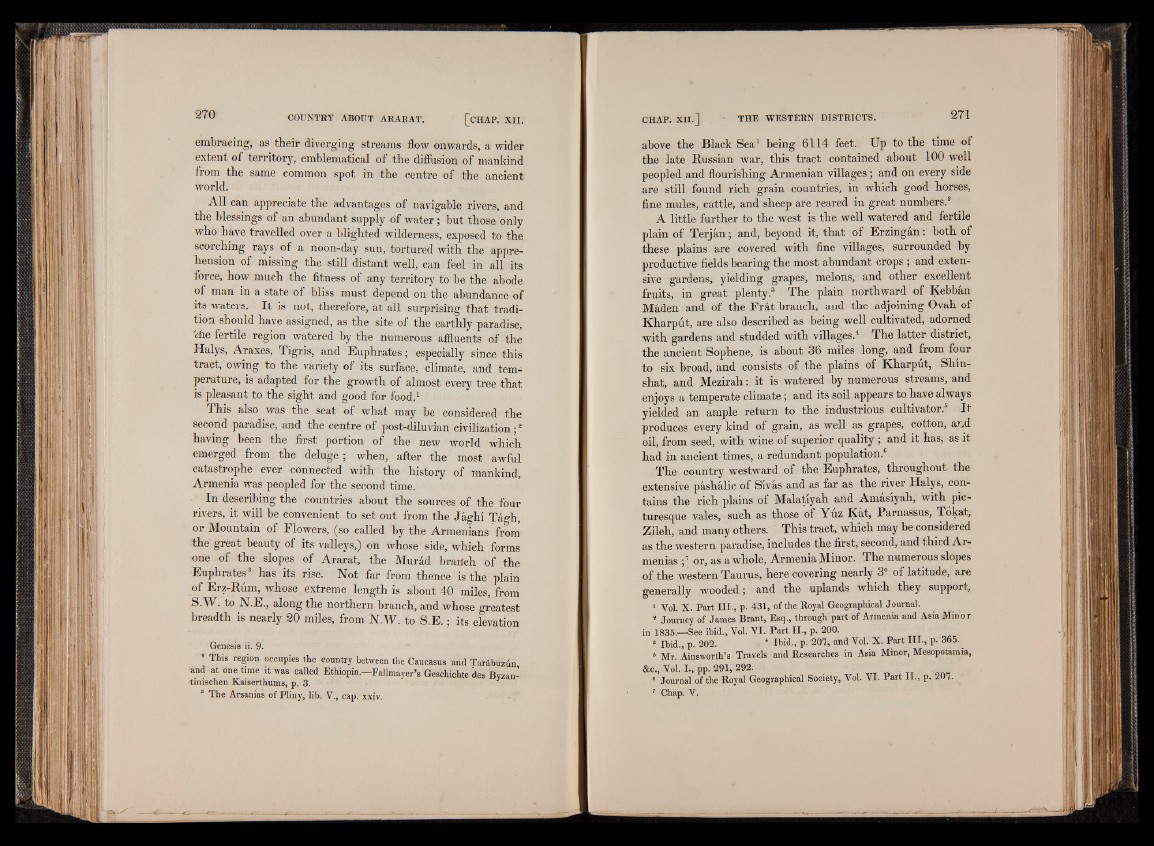
embracing, as their diverging streams flow onwards, a wider
extent of territory, emblematical of the diffusion of mankind
from the same common spot in the centre of the ancient
world.
All can appreciate the advantages of navigable rivers, and
the blessings of an abundant supply of water; but those only
who have travelled over a blighted wilderness, exposed to the
scorching rays of a noon-day sun, tortured with the apprehension
of missing the still distant well, can feel in all its
force, how much the fitness of any territory to be the abode
of man in a state of bliss must depend on the abundance of
its waters. It is not, therefore, at all surprising that tradition
should have assigned, as the site of the earthly paradise,
'¿fie fertile region watered by the numerous afliuents of the
Halys, Araxes, Tigris, and Euphrates; especially since this
tract, owing to the variety of its surface, climate, and temperature,
is adapted for the growth of almost every tree that
is pleasant to the sight and good for food.1
This also was the seat of what may be considered the
second paradise, and the centre of post-diluvian civilization;2
having been the first portion of the new world which
emerged from the deluge; when, after the most awful
catastrophe ever connected with the history of mankind,
Armenia was peopled for the second time.
In describing the countries about the sources of the four
rivers, it will be convenient to set out from the Jaghi Tagh,
or Mountain of Flowers, (so called by the Armenians from
the great beauty of its valleys,) on whose side, which forms
one of the: slopes of Ararat, the Murad brarfch of the
Euphrates3 has its rise. Not far from thence is the plain
of Erz-Rum, whose extreme length is about 40 miles, from
S.^SV. to N.E., along the northern branch, and whose greatest
breadth is nearly 20 miles, from N.W. to S.E. ; its elevation
Genesis ii. 9.
! This region occupies the country between the Caucasus and Tarabuzun
and at one time it was called Ethiopia.—Fallmayer’s Geschichte des Byzan-
tinischen Kaiserthums; p. 3. '
2 The Arsanias of Pliny, lib. V., cap. xxiv.
above the Black Sea1 being 6114 feet. Up to the time of
the late Russian war, this tract contained about 100 well
peopled and flourishing Armenian villages; and on every side
are still found rich grain countries, in which good horses,
fine mules, cattle, and sheep are reared in great numbers.2
A little further to the west is the well watered and fertile
plain of Terjan; and, beyond it, that of Erzingan: both of
these plains are covered with fine villages, surrounded by
productive fields bearing the most abundant crops ; and extensive
gardens, yielding grapes, melons, and other excellent
fruits, in great plenty.3 The plain northward of Kebban
Maden and of the Frat branch, and the adjoining Ovah of
Kharput, are also described as being well cultivated, adorned
with gardens and studded with villages.4 The latter district,
the ancient Sophene, is about 36 miles long, and from four
to six broad, and consists of the plains of Kharput, Shin-
shat, and Mezirah: it is watered by numerous streams, and
enjoys a temperate climate; and its soil appears to have always
yielded an ample return to the industrious cultivator. If
produces every kind of grain, as well as grapes, cotton, ar,d
oil, from seed, with wine of superior quality ; and it has, as it
had in ancient times, a redundant population.6
The country westward of the Euphrates, throughout the
extensive pashalic of Sivas and as far as the river Halys, contains
the rich plains of Malatiyah and Amasiyah, with picturesque
vales, such as those of Yuz Kat, Parnassus, Tokat,
Zileh, and many others. This tract, which may be considered
as the western paradise, includes the first, second, and third Ar-
menias ;7 or, as a whole, Armenia Minor. The numerous slopes
of the western Taurus, here covering nearly 3° of latitude, are
generally wooded; and the uplands which they support,
1 Vol. X. Part III., p. 431, of the Royal Geographical Journal.
* Journey of James Brant, Esq., through part of Armenia and Asia Minor
in 1835.— See ibid., Vol. VI. Part II., p. 200.
a TljilGf p. 202. ■ 4 Ibid., p. 207, and Vol. X. Part III., p. 365.
5 Mr. Ainsworth’s Travels and Researches in Asia Minor, Mesopotamia,
&c., Vol. I ., pp. 291, 292.
e Journal of the Royal Geographical Society, Vol. VI. Part II., p. 207.
7 Chap. V.